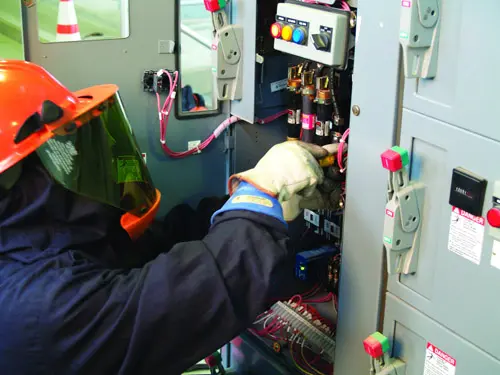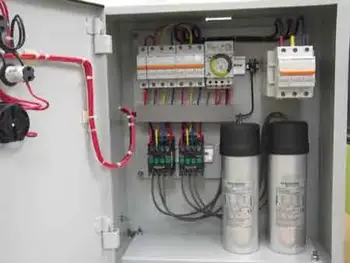Who is at risk of an arc flash?
By R.W. Hurst, Editor

CSA Z462 Arc Flash Training - Electrical Safety Essentials
Our customized live online or in‑person group training can be delivered to your staff at your location.

- Live Online
- 6 hours Instructor-led
- Group Training Available
Download Our OSHA 3875 Fact Sheet – Electrical PPE for Power Industry Workers

- Follow rules for rubber gloves, arc-rated PPE, and inspection procedures
- Learn employer obligations for testing, certification, and training
- Protect workers from arc flash and electrical shock injuries
Who is at risk of an arc flash? Electricians, maintenance technicians, and engineers near energized equipment, switchgear, or substations face hazards from fault current and incident energy; NFPA 70E, PPE, and lockout/tagout mitigate exposure.
Who Is at Risk of an Arc Flash?
Workers near energized equipment—especially electricians and techs—face arc flash risk; NFPA 70E and PPE reduce hazards.
✅ Electricians, E&I techs, and field engineers near live circuits
✅ Workers operating switchgear, MCCs, and substation equipment
✅ Staff performing testing, racking, or maintenance without LOTO/PPE
Who is at risk of an arc flash?
Those at risk of an arc flash include anyone working on or near energized electrical equipment, especially electricians, maintenance personnel, and contractors. Even bystanders may be injured due to blast pressure, fire, or flying debris. For a concise explanation of the phenomenon, see this introduction to arc flash for additional context.
Immediate Threats
The most immediate and severe threat is to those working within the reach of the arc flash. The distance that an arc flash can affect depends on various factors, including the system's voltage and environmental conditions. Conducting an arc flash hazard analysis helps identify these high-risk areas, where stringent precautions, including the use of personal protective equipment (PPE), are necessary. Facilities often mark these zones using floor marking tape or other visual indicators to alert workers of the danger. Detailed definitions of boundaries and hazard categories are outlined in the arc flash hazard guidance for practitioners.
Secondary Threats
In addition to the risk of electrocution, arc flashes pose several secondary threats to those nearby. These threats include:
Understanding the conditions under which an arc flash can occur helps teams tailor lockout procedures and training.
-
Fires: The intense heat from an arc flash can ignite surrounding materials, leading to potentially large fires.
-
Flying Debris: The force of an arc flash or resulting explosion can send debris flying, which can cause serious injuries.
-
Explosions: Arc flashes can trigger explosions, posing further risks to anyone in the vicinity.
These secondary threats can cause immediate harm and set the stage for additional hazards. Further insight into blast dynamics is provided in this arc flash blast and explosion overview for planning and drills.
Test Your Knowledge About Arc Flash!
Think you know Arc Flash? Take our quick, interactive quiz and test your knowledge in minutes.
- Instantly see your results and score
- Identify strengths and areas for improvement
- Challenge yourself on real-world electrical topics
Tertiary Threats
After addressing the immediate and secondary threats, it's essential to consider the tertiary threats posed by an arc flash. These threats can affect everyone in the facility and even those in the surrounding area. Potential tertiary threats include: A broad technical primer is available in the electrical arc flash fundamentals to frame these broader impacts.
-
Spreading Fires: Fires ignited by an arc flash can spread rapidly, endangering more people and causing extensive damage.
-
Hazardous Chemicals: In facilities that store hazardous chemicals, an arc flash can cause spills or release toxic substances into the air.
-
Structural Damage: The explosion and heat from an arc flash can weaken structural components, posing additional risks.
For prevention, review common initiators such as contamination, loose connections, and improper work practices in what causes an arc flash to inform your corrective actions.
Responding to an Arc Flash
Recognizing the broad range of risks associated with an arc flash underscores the importance of prevention and preparedness. To mitigate these risks, facilities should:
-
Implement Preventive Measures: Regular maintenance, proper insulation, and adherence to safety protocols can reduce the likelihood of an arc flash.
-
Conduct Hazard Analyses: Regularly assessing the facility for arc flash risks helps identify and mitigate potential hazards.
-
Develop Response Plans: Having effective response strategies in place ensures that, if an arc flash occurs, the facility can minimize damage and protect its workers.
Arc flashes pose significant risks not only to those working directly with electrical systems but also to others in the vicinity and potentially the entire facility. By understanding these risks and implementing comprehensive safety measures, facilities can better protect their workers and minimize the dangers associated with arc flashes. Response plans should also address first aid and post-incident care, with lessons summarized in these arc flash victim case insights to strengthen training.
Related Resources








